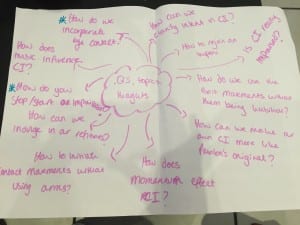So I have been participating in the contact improvisation lessons for a month and I am starting to feel more confident in my movement choices and trusting my peers with my weight. The lesson started with us standing still in neutral position, closing our eyes and listening to our inner body. I found it hard to stand still without fidgeting or moving any part of my body. The idea of closing my eyes scares me so this was challenging to keep my eyes closed for a long time. Even though we were told to stay still my body was constantly moving I could not help but feel dizzy when having my eyes closed and the sensations running through my body were never still. The idea of moving my weight into different positions of the foot was difficult as when closing my eyes I had already felt dizzy before moving. Holding the position either on my heels or toes made me instantly use my abdominals to try and stay there.
When getting into partners I try to work with everyone in the room at some point as this gives me the opportunity to see who I work well with and who I struggle with. When we was in partners the idea was that we had to improvise with each other using contact, then one dancer would say stop. When the dancer said stop the other dancer then had to find a counter balance on their partner. When completing the exercise I found it easier for my partner to put their weight on me as I feel like I was more stable with my positions, however this might have changed depending on different peers I was working with. Sometimes I feel like a great difference in height made a difference on who was putting their weight on who, as I am quite tall working with a smaller dancer it just fell to the smaller person always putting her weight on me. I find this exercise easier standing rather than the floor as my movement knowledge and lifting on the floor I feel restricted in. On the other hand performing this exercise whilst standing allowed us more freedom.
Weight bearing in contact improvisation is a key factor. From the reading ‘Sensing weight in movement’ by Susanne Ravn, the key points which stood out to me was how dancers with previous dance training hold their weight differently. For example ballet dancers hold their weight vertically ‘gravity is not to be defeated by activating controlled elongation and creating lines out of the space’ (Ravn, 2010, 26). Unlike a contemporary dancer as their weight is grounded and the concentration is more on how the body feels instead of what the body looks like. Proprioception is used in all areas of the dancer techniques and also used in contact improvisation. For myself being from a ballet background this is a way which I can connect ballet and contact improvisation together. As when performing contact improvisation you have to use these skills to see the dancers around you to connect with them and for safety and the same applies with the ballet technique too.
One of the final exercise included us to put all of our trust into our peers. This included standing in a circle whilst one person goes into the middle of the circle and shouts ‘1-2-3’ and on three they would fall backwards. The dancers who were near the dancer in the middle had to run to them to gradually help them down and taking extra care of the head. At the start of this exercise everyone was nervous about going into the middle as you had to put your 100% trust on people catching you. When I went into the middle I was anxious to see what would happen but I enjoyed the feeling of being in a way lifted to the floor. The final exercise included us getting into groups and lifting someone from the group in the air horizontally. The group which I was in felt comfortable with lifting everyone and everyone who was lifted felt safe. As a group I feel like we achieved something quite big as some people in our group had never been lifted before or either don’t like being lifted. By the end of the exercise everyone had ago at every position and everyone had been lifted which was a great feeling. The body part which I went towards holding the most was the head, I am not sure why but I felt comfortable holding the head with strength as you have to be careful it doesn’t drop as it can cause injury.
Research Labs
In the group there is four other people and I for the research lab. Over the few sessions we have been told to think of questions which we would like to discover, so when we was told to put the questions we had built up over the past couple of weeks on paper our ideas kept flowing. When discussing our final 2 two questions which we wanted to discover more in depth it was a unanimous vote the two questions are:
- How do we incorporate eye contact in improvisation?
- Who initiates the movement after a weight bearing position, the under or over dancer?
The group decided to choose this questions as from watching the videos we felt like these were lacking in the reflection of our contact. We now need to think of some tasks which could reflect our questions and form our research including small group tasks and feedback from our peers.
Questions which I ask myself
What effect would the changing of weight have on our contact in improvisation?
Does proprioception come naturally to us all during improvisation?
Bibliography
Ravn, S. (2010) Sensing Weight in Movement. Journal of Dance and Somatic Practices, 2(1) 21-34.
